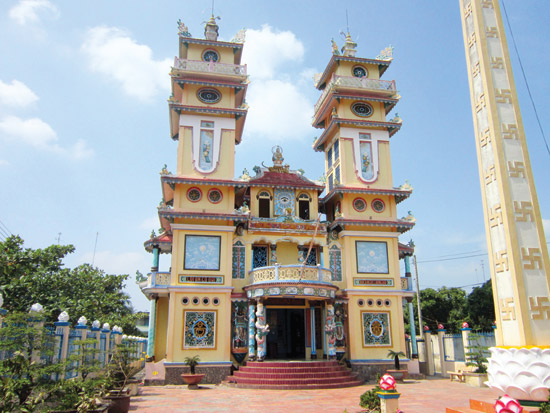(No.5, Vol.3, June 2013 Vietnam Heritage Magazine)
Buddhist statues wear raincoats
tuoitrenews.vn, 16 May
Following the ‘ultimatum’ filed by the head of Hanoi’s hallmark One-Pillar pagoda, in which he said he will carry out renovations if his petition goes unheeded again, a meeting was held by local government on 15 May to discuss the project to revamp the pagoda.
Venerable Kien lamented that the pagoda, which is believed to have been built in 1049, suffers flooding after rains. Its Buddha statues even have to be covered with raincoats and hats, but raindrops still seep in, taking their toll.
Old letter seeks Vietnamese-Japanese relations
english.vietnamnet.vn, 17 April
A highly significant and historic diplomatic letter from Vietnam to Japan, written in 1591, is now on exhibition in Japan.
The letter was written by a Vietnamese mandarin seeking to set up diplomatic relations with Japan.
It was found in a shop dealing in rare books in the old royal capital of Kyoto and placed with the other letters in the Kyushu National Museum.
‘The letter expresses Vietnam’s strong determination to trade with Japan,’ Reio Fujita, a representative of the museum, told Vietnam News Agency. ‘It is a valuable document showing that the two countries set up an official relationship more than 400 years ago.’
Japanese historians estimate that Vietnam sent about 20 letters to Japan in that period. This was once considered the oldest letter from Vietnam to Japan, but it was lost many years ago.
Thanks, but no thanks
Lao Dong, 22 May
In late May, Party Secretary of the Hanoi Communist Party Committee, Mr Pham Quang Nghi, apologized to the villagers of Duong Lam, after they submitted a petition saying that they wanted to return the village’s status of national heritage treasure to the government.
Villagers say that they benefit nothing from the status, but instead, it hinders repair work and the building of new houses.
The village was recognized as a National Relic by the government in 1995. It is considered a living museum of rural life in the Red River Delta. Since then, no development plan has been approved for the village.
Swastika ban led to Cao Dai persecution
Decree No. 72, dated 3 May, 1940 by Governor General of Indochina Geogres Catroux, banned all religious flags as well as banners bearing the sign of the swastika, because of its resemblance to the main symbol of Nazism in the Second World War according to Caodaism under Persecution in Central Vietnam 1928-1950, Hue Khai, Ton Giao Publisher, Hanoi, 2012. As a result, a multitude of Caodaist temples were closed from province to province in the whole country. The swastika, a stylized picture of the sun, is an ancient symbol of good luck, life and power. The sign is not banned now.

The Swastika at a Cao Dai temple in Cai Be, Tien Giang, Mekong delta. Photo: http://upload.wikimedia.org
Sarasvati is the goddess of speech
tuoitrenews.vn, 29 May
The first Hindi – Vietnamese dictionary debuted in May in Ho Chi Minh City.
The dictionary, compiled by Indian teacher Sadhna Saxena and her Vietnamese co-author Pham Dinh Huong, has more than 9,000 entries, including 7,500 main entries and 1,500 sub-categories.
In addition, it also contains popular Hindi idioms and proverbs commonly used in daily conversation.
The dictionary is published under an agreement between the Indian Consulate General in HCMC, which sponsored the project, and Ho Chi Minh City University of Social Sciences and Humanities.
Hindi is India’s national language.
‘Rice Seller’ harvests 3 mil
www.bloomberg.com, 27 May
A 1932 painting by Nguyen Phan Chanh entitled ‘La Marchand de Riz’, or ‘The Rice Seller’ sold for HK$3.03 million ($390,000), setting a record for a Vietnamese artist’s work at Christie’s International in Hong Kong.
‘The provenance is impeccable,’ Jean-Francois Hubert, Christie’s senior consultant for Vietnamese art, said in the salesroom. ‘It’s in its original frame by Parisian framer Gadin and it was exhibited in 1934 in Napoli.’
The buyer of the ink and gouache on silk painting, Kong Kong-based dealer Pascal de Sarthe, said he and his wife Sylvie plan to hang it in their bedroom.
The previous highest price for a Vietnamese artist at auction was set in April 2012 when Le Pho’s work sold for HK$2.9 million at Sotheby’s (BID) in Hong Kong.
Accident caused blackout
english.vietnamnet.vn, 22 May & tuoitrenews.vn, 22 May
A crane hit the 500 KV transmission line that carries power from Northern Vietnam to Southern Vietnam, causing power outages in all 22 southern provinces late May. This is the worst outage Vietnam has ever had, according to the government.
The crane was working to plant a tree in the southern province of Binh Duong when the tree banged into the line.
Currently the South, at peak usage, imports 40 per cent of its power from the North.

